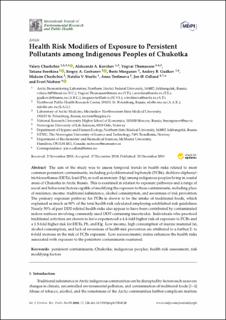| dc.contributor.author | Chashchin, Valery | |
| dc.contributor.author | Kovshov, Aleksandr A. | |
| dc.contributor.author | Thomassen, Yngvar | |
| dc.contributor.author | Sorokina, Tatiana | |
| dc.contributor.author | Gorbanev, Sergey A. | |
| dc.contributor.author | Morgunov, Boris | |
| dc.contributor.author | Gudkov, Andrey B. | |
| dc.contributor.author | Chashchin, Maxim | |
| dc.contributor.author | Sturlis, Natalia V. | |
| dc.contributor.author | Trofimova, Anna | |
| dc.contributor.author | Odland, Jon Øyvind | |
| dc.contributor.author | Nieboer, Evert | |
| dc.date.accessioned | 2022-05-04T10:01:08Z | |
| dc.date.available | 2022-05-04T10:01:08Z | |
| dc.date.created | 2020-10-26T13:36:13Z | |
| dc.date.issued | 2020 | |
| dc.identifier.citation | International Journal of Environmental Research and Public Health (IJERPH). 2020, 17 (1), . | en_US |
| dc.identifier.issn | 1661-7827 | |
| dc.identifier.uri | https://hdl.handle.net/11250/2994097 | |
| dc.description.abstract | The aim of the study was to assess temporal trends in health risks related to most common persistent contaminants, including polychlorinated biphenyls (PCBs), dichloro-diphenyl-trichloroethanes (DDTs), lead (Pb), as well as mercury (Hg) among indigenous peoples living in coastal areas of Chukotka in Arctic Russia. This is examined in relation to exposure pathways and a range of social and behavioral factors capable of modifying the exposure to these contaminants, including place of residence, income, traditional subsistence, alcohol consumption, and awareness of risk prevention. The primary exposure pathway for PCBs is shown to be the intake of traditional foods, which explained as much as 90% of the total health risk calculated employing established risk guidelines. Nearly 50% of past DDT-related health risks also appear to have been contributed by contaminated indoor surfaces involving commonly used DDT-containing insecticides. Individuals who practiced traditional activities are shown to have experienced a 4.4-fold higher risk of exposure to PCBs and a 1.3-fold higher risk for DDTs, Pb, and Hg. Low income, high consumption of marine mammal fat, alcohol consumption, and lack of awareness of health risk prevention are attributed to a further 2- to 6-fold increase in the risk of PCBs exposure. Low socioeconomic status enhances the health risks associated with exposure to the persistent contaminants examined. | en_US |
| dc.language.iso | eng | en_US |
| dc.publisher | MDPI | en_US |
| dc.rights | Navngivelse 4.0 Internasjonal | * |
| dc.rights.uri | http://creativecommons.org/licenses/by/4.0/deed.no | * |
| dc.title | Health risk modifiers of exposure to persistent pollutants among indigenous peoples of Chukotka | en_US |
| dc.title.alternative | Health risk modifiers of exposure to persistent pollutants among indigenous peoples of Chukotka | en_US |
| dc.type | Peer reviewed | en_US |
| dc.type | Journal article | en_US |
| dc.description.version | publishedVersion | en_US |
| dc.source.pagenumber | 10 | en_US |
| dc.source.volume | 17 | en_US |
| dc.source.journal | International Journal of Environmental Research and Public Health (IJERPH) | en_US |
| dc.source.issue | 1 | en_US |
| dc.identifier.doi | 10.3390/ijerph17010128 | |
| dc.identifier.cristin | 1842303 | |
| cristin.ispublished | true | |
| cristin.fulltext | original | |
| cristin.qualitycode | 1 | |

